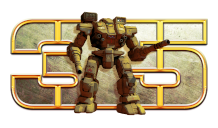- Home
- New To BattleTech?
- MUL
- Forums
- News
- Books
- Shrapnel
- Universe
- Downloads
- Characters
- Community
- Errata
- Links
- Gallery
Online Canon — Space Colonies
In its heyday, the Star League made possible the habitation of hundreds of worlds that were only marginally capable of supporting a human population. Poisonous atmospheres were rendered clean and breathable. Dark, cold planets were warmed and lit by artificial suns. In rare cases, planets were replaced by their technological equivalent – huge space colonies. Capable of supporting thousands of adventuring pioneers who chose to make their living far from any planetary body, the space habitats arose for the benefit of corporations and the military at first, perhaps to mine a local asteroid belt or to provide a safe haven between worlds too distant for a single ship’s jump. Over time these floating colonies became a home to more than military troops or corporate miners.
Ravaged by war and piracy in the years following the fall of the Star League, most of the space habitat stations in current use date back to Star League times, and can only be found in the heart of the Successor States or Clan space. Vaguely resembling JumpShips, these giant space stations generally hold a fixed position within a planetary system and can provide a comfortable existence for thousands of people at once – though some habitats built in the Star League’s heyday have been able to support populations of more than a million strong. The largest habitat station in current use floats just inside the orbit of a large asteroid belt in the CMO 26 system – whose name was recently formally changed to Gulf Breeze – located in the Lyran Alliance’s Coventry Province. Providing living space to just over 200,000 people, this ancient station boasts almost all the amenities of home, from large, apartment-style living quarters to a small military barracks for the station’s marine defense force, to entertainment casinos and even a sports arena.
Life aboard an orbiting habitat is a curious mix between travel aboard a DropShip or JumpShip and existing in a close-knit urban neighborhood. The confined quarters aboard a spinning space habitat must be used as pragmatically as possible, and so most stations are rigidly organized into military, commercial and residential sectors. Entire decks serve as tightly packed apartment blocks, barely more luxurious than a typical two-bedroom apartment in a planet-bound suburb. Typically located in the central areas of the habitat, the residential sector is commonly bordered on each side by commercial districts that are themselves little more than a single, continuous strip mall of converted quarters – though larger stations include other amenities, such as casinos, theaters and even sports stadiums. Industrial sectors, which include station machine shops, repair bays and the like, tend to border the opposite ends of the commercial zones, and may or may not be set within gravity-free sections of the station (as opposed to the spinning grav decks reserved primarily for residential and commercial zones). Military and administrative zones almost always are situated at the fore and aft of the station, where they can best defend and coordinate with the station command center in the bow and the engineering sectors in the aft. Because few stations offer as much room as a sprawling, planetside metropolis, most habitat dwellers know one another very well, like the people of a small rural town. Consequently, most habitat communities are close-knit and independent-minded, feeling genuine kinship only with others who spend most of their lives in the void of space. Often simply called spacers, the inhabitants of space colonies tend to be friendlier toward JumpShip and DropShip crews, who also spend most of their time off-planet, than toward those who spend most of their lives on the relative safety of a planetary surface.
Though often equipped with hydroponic gardens to grow vegetables and fruits, most habitat communities don’t have room for raising cattle or other livestock and are ill equipped to grow enough food for their entire population. Despite efficient recycling systems, water and air stores must also be replenished from time to time, so no habitat station can ever be considered truly self-sufficient. For this reason, every station maintains a brisk trade with nearby worlds in order to supplement the colonists’ basic food and water needs. Work aboard the space colonies also conforms to the colony’s needs. Because living room aboard a station is scarce and the inhabitants’ needs are many, most spacers perform multiple roles for their colony, usually maintaining a primary trade as merchants, marines, administrators or some such, while doubling as a part-time astechs or medics should the need arise. This practice further enhances the independent attitude of space colonists.
In game terms, characters choosing to hail from a space colony must first choose a Clan or major Inner Sphere Affiliation (Combine, Confederation, League, Suns or Alliance). The character automatically receives the Introvert Trait and automatically picks up 3 skill points in Zero-G Operations during Stage 1 of the Life Path process. Additionally, characters who remain on the habitat – regardless of path – in Stage 2 may choose any three skills from the Aerospace Technician, Civilian Tech or Engineer skill fields, adding 2 points to one skill, and 1 to the other two, while adding 2 more skill points to Zero-G Operations. Finally, the Transit Disorientation Syndrome Trait may not be chosen in the final stage of character generation.
 BattleTech is a science-fiction “space opera”: a factional, militarized universe set in the thirty-first century, a future where humanity has spread to the stars and spawned titanic interstellar empires, each nation controlling hundreds of worlds across a region of space stretching a thousand light years and beyond.
BattleTech is a science-fiction “space opera”: a factional, militarized universe set in the thirty-first century, a future where humanity has spread to the stars and spawned titanic interstellar empires, each nation controlling hundreds of worlds across a region of space stretching a thousand light years and beyond.
Initially published over thirty years ago as a tabletop board game, BattleTech has gone on to become one of the gaming industry’s most important and longest-lasting science-fiction universes.
Be sure to check out the latest BattleTech Releases and the Coming Soon page for the newest BattleTech products.






